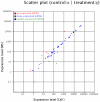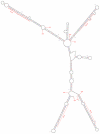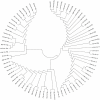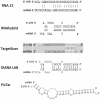Solexa sequencing identification of conserved and novel microRNAs in backfat of Large White and Chinese Meishan pigs
- PMID: 22355364
- PMCID: PMC3280305
- DOI: 10.1371/journal.pone.0031426
Solexa sequencing identification of conserved and novel microRNAs in backfat of Large White and Chinese Meishan pigs
Abstract
The domestic pig (Sus scrofa), an important species in animal production industry, is a right model for studying adipogenesis and fat deposition. In order to expand the repertoire of porcine miRNAs and further explore potential regulatory miRNAs which have influence on adipogenesis, high-throughput Solexa sequencing approach was adopted to identify miRNAs in backfat of Large White (lean type pig) and Meishan pigs (Chinese indigenous fatty pig). We identified 215 unique miRNAs comprising 75 known pre-miRNAs, of which 49 miRNA*s were first identified in our study, 73 miRNAs were overlapped in both libraries, and 140 were novelly predicted miRNAs, and 215 unique miRNAs were collectively corresponding to 235 independent genomic loci. Furthermore, we analyzed the sequence variations, seed edits and phylogenetic development of the miRNAs. 17 miRNAs were widely conserved from vertebrates to invertebrates, suggesting that these miRNAs may serve as potential evolutional biomarkers. 9 conserved miRNAs with significantly differential expressions were determined. The expression of miR-215, miR-135, miR-224 and miR-146b was higher in Large White pigs, opposite to the patterns shown by miR-1a, miR-133a, miR-122, miR-204 and miR-183. Almost all novel miRNAs could be considered pig-specific except ssc-miR-1343, miR-2320, miR-2326, miR-2411 and miR-2483 which had homologs in Bos taurus, among which ssc-miR-1343, miR-2320, miR-2411 and miR-2483 were validated in backfat tissue by stem-loop qPCR. Our results displayed a high level of concordance between the qPCR and Solexa sequencing method in 9 of 10 miRNAs comparisons except for miR-1a. Moreover, we found 2 miRNAs, miR-135 and miR-183, may exert impacts on porcine backfat development through WNT signaling pathway. In conclusion, our research develops porcine miRNAs and should be beneficial to study the adipogenesis and fat deposition of different pig breeds based on miRNAs.
Conflict of interest statement
Figures







Similar articles
-
Discovery of porcine microRNAs in multiple tissues by a Solexa deep sequencing approach.PLoS One. 2011 Jan 25;6(1):e16235. doi: 10.1371/journal.pone.0016235. PLoS One. 2011. PMID: 21283541 Free PMC article.
-
MicroRNA identity and abundance in developing swine adipose tissue as determined by Solexa sequencing.J Cell Biochem. 2011 May;112(5):1318-28. doi: 10.1002/jcb.23045. J Cell Biochem. 2011. PMID: 21312241
-
Identification of differentially expressed small RNAs and prediction of target genes in Italian Large White pigs with divergent backfat deposition.Anim Genet. 2018 Jun;49(3):205-214. doi: 10.1111/age.12646. Epub 2018 Mar 23. Anim Genet. 2018. PMID: 29570818
-
MicroRNA expression profiles differ between primary myofiber of lean and obese pig breeds.PLoS One. 2017 Jul 31;12(7):e0181897. doi: 10.1371/journal.pone.0181897. eCollection 2017. PLoS One. 2017. PMID: 28759650 Free PMC article.
-
Discovery of porcine miRNA-196a/b may influence porcine adipogenesis in longissimus dorsi muscle by miRNA sequencing.Anim Genet. 2017 Apr;48(2):175-181. doi: 10.1111/age.12520. Epub 2016 Oct 24. Anim Genet. 2017. PMID: 27775171
Cited by
-
Fatty acid-binding protein 1 increases steer fat deposition by facilitating the synthesis and secretion of triacylglycerol in liver.PLoS One. 2019 Apr 22;14(4):e0214144. doi: 10.1371/journal.pone.0214144. eCollection 2019. PLoS One. 2019. PMID: 31009469 Free PMC article.
-
Comparative transcriptome analysis reveals significant differences in MicroRNA expression and their target genes between adipose and muscular tissues in cattle.PLoS One. 2014 Jul 9;9(7):e102142. doi: 10.1371/journal.pone.0102142. eCollection 2014. PLoS One. 2014. PMID: 25006962 Free PMC article.
-
miR-215 Targeting Novel Genes EREG, NIPAL1 and PTPRU Regulates the Resistance to E.coli F18 in Piglets.Genes (Basel). 2020 Sep 7;11(9):1053. doi: 10.3390/genes11091053. Genes (Basel). 2020. PMID: 32906628 Free PMC article.
-
Analysis of miRNAs and their target genes associated with lipid metabolism in duck liver.Sci Rep. 2016 Jun 8;6:27418. doi: 10.1038/srep27418. Sci Rep. 2016. PMID: 27272010 Free PMC article.
-
Castration-induced changes in microRNA expression profiles in subcutaneous adipose tissue of male pigs.J Appl Genet. 2014 May;55(2):259-66. doi: 10.1007/s13353-014-0194-0. Epub 2014 Jan 26. J Appl Genet. 2014. PMID: 24464334
References
-
- Lee RC, Feinbaum RL, Ambros V. The C. elegans heterochronic gene lin-4 encodes small RNAs with antisense complementarity to lin-14. Cell. 1993;75:843–854. - PubMed
-
- Pillai RS, Bhattacharyya SN, Filipowicz W. Repression of protein synthesis by miRNAs: how many mechanisms? Trends Cell Biol. 2007;17:118–126. - PubMed
-
- Zhang B, Pan X, Cobb GP, Anderson TA. Plant microRNA: a small regulatory molecule with big impact. Dev Biol. 2006;289:3–16. - PubMed
-
- Ambros V. The functions of animal microRNAs. Nature. 2004;431:350–355. - PubMed
-
- Cullen BR. Viruses and microRNAs. Nat Genet. 2006;38:S25–S30. - PubMed
Publication types
MeSH terms
Substances
LinkOut - more resources
Full Text Sources
Other Literature Sources

